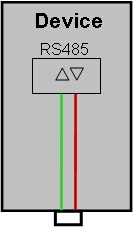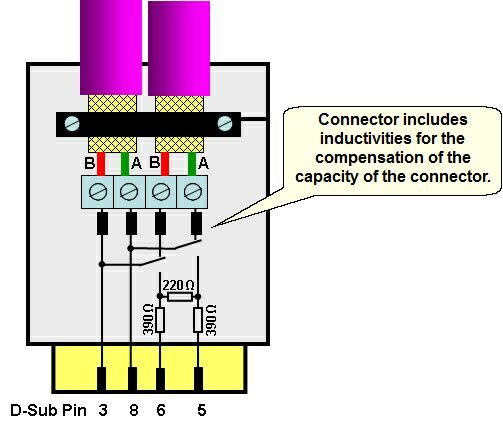
PROFIBUS Manual
Stub lines (T-pieces) are branches off the main segment.

Stub lines are never allowed when bit rates in excess of 1.5 Mbit/s are used. For bit rates up to 1.5 Mbit/s stub lines may be used if they do not exceed the limits indicated in the following table.
With stub lines, no additional bus termination is used.
Bit rate |
Overall capacitance allowed |
Total length of stub lines* |
>1.5Mbit/s |
None |
None |
1.5Mbit/s |
0.2 nF |
6.7m |
500kbit/s |
0.6 nF |
20m |
187.5kbit/s |
1.0 nF |
33m |
93.75kbit/s |
3.0 nF |
100m |
19.2kbit/s |
15 nF |
500m |
* Calculated with a PROFIBUS cable type A at 30pF/m
 Stub line inside the device |
Please note that the lengths listed here represent the total of all stub lines belonging to a segment. It is necessary to deduct from it the stub present in every device between the socket and the RS 485 line driver. |
These figures relate to the total of stub lines, i.e. for a cable with 187,5 kbit/s and 32 connected devices, the average stub length per device should be approx. 1 metre. At bits of more than 1.5 Mbit/s stub lines are not allowed. Connectors available on the market offer a way of connecting the incoming and outgoing data cable directly in the connector. Stub lines are thereby avoided and the bus connector can be inserted or removed at any time, without interrupting data traffic.
In practice this is not quite so easy. Even if the bus cable is connected in a plug directly on the device, a minimum stub of a few cm remains inside the device between the device connector and the line driver. The standard therefore specifies that the capacitance of any connector intended for use with 12 Mbit/s should not exceed the maximum of 35 pF. If this cannot be complied with, series inductors must be used to offset this capacitance (c.f. the formula for line inductance).

At bit rates over 1.5 MBit/s a minimum cable length of 1 m is recommended between two stations. This ensures that reflections caused by improper connections will be delayed in the signal by the running time of one metre (approx. 5 ns) and the effect of noise on the signal is not added to the total. The installation is less fault-prone.
Avoid stub lines whenever possible. Use repeaters to create any branches.
